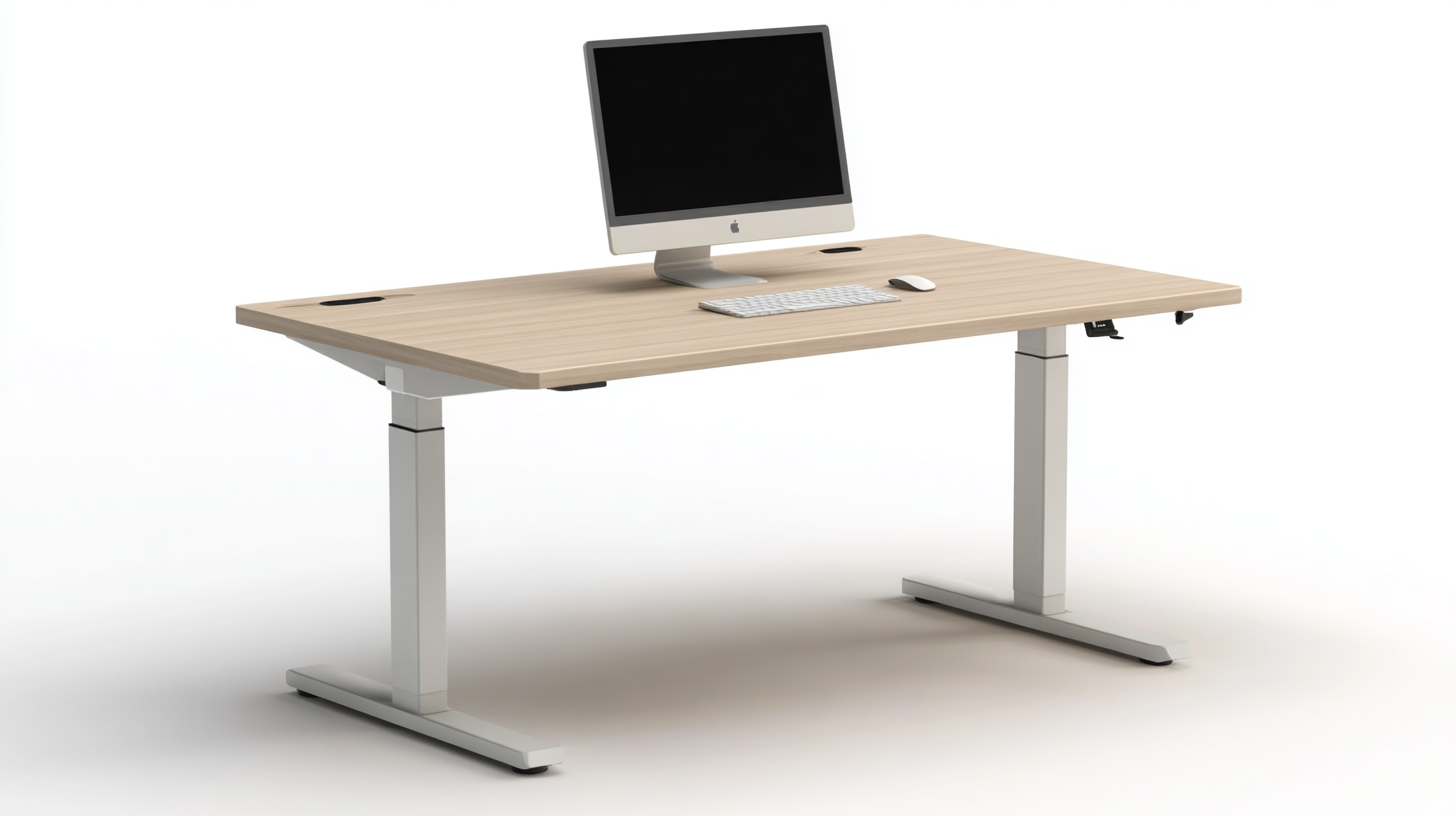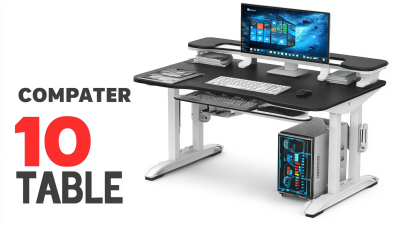In today's fast-paced work environment, the design and ergonomics of a workspace play a crucial role in enhancing productivity and overall well-being. A recent study by the American Psychological Association highlights that ergonomically designed workspaces can increase productivity by up to 23% and reduce work-related injuries significantly. One of the key elements in creating an ergonomic workspace is the choice of a suitable "Computer Table." A properly designed computer table not only supports better posture but also accommodates individual needs, allowing for adjustments in height and surface area, which can lead to a more comfortable and efficient working experience. With the right computer table, employees can maintain focus and energy levels throughout the day, resulting in improved performance and job satisfaction. As organizations begin to recognize these benefits, investing in quality ergonomic solutions like a computer table becomes imperative for fostering a productive and healthy work environment.

 Understanding ergonomics is essential for creating a productive workspace. Ergonomics refers to the science of designing a workplace that fits the user's needs, thereby enhancing comfort and efficiency. When it comes to computer tables, an ergonomic design considers factors like height, adjustability, and surface area. A well-designed computer table can reduce strain on the body, minimize the risk of repetitive strain injuries, and promote better posture, allowing you to work more efficiently for longer periods.
Understanding ergonomics is essential for creating a productive workspace. Ergonomics refers to the science of designing a workplace that fits the user's needs, thereby enhancing comfort and efficiency. When it comes to computer tables, an ergonomic design considers factors like height, adjustability, and surface area. A well-designed computer table can reduce strain on the body, minimize the risk of repetitive strain injuries, and promote better posture, allowing you to work more efficiently for longer periods.
Tips for an Ergonomic Workspace:
By prioritizing ergonomic principles in your workspace design, you can create an environment that significantly boosts your productivity and overall well-being.
When considering the key features of an ergonomic computer table, it's essential to understand how each aspect can significantly enhance productivity. According to the American Psychological Association, poor workstation ergonomics can increase discomfort and inhibit performance, with studies indicating that employees can lose up to 20% of their productivity due to ineffective workspace designs. An ergonomic computer table usually includes adjustable height settings, which allow users to alternate between sitting and standing, reducing the risk of musculoskeletal disorders. These tables promote a healthier posture, leading to fewer distractions and improved focus during work hours.
Additionally, an ergonomic computer table typically incorporates ample workspace and thoughtful cable management solutions. This design minimizes clutter, which research from the University of Princetown highlights as a contributing factor to reduced stress levels and improved cognitive function. Features such as curved edges and appropriately placed monitors or keyboards ensure that users maintain a comfortable distance from screens and a neutral wrist position, further enhancing comfort. Ultimately, investing in an ergonomic computer table is not just a personal health choice; it’s a strategic decision that can lead to significant productivity gains in the workplace.
Creating an ergonomic workspace is essential for maximizing productivity and ensuring comfort during long hours of computer use. According to the Occupational Safety and Health Administration (OSHA), discomfort due to poor workstation setup can lead to repetitive strain injuries and decreased efficiency. By focusing on how to set up your computer table for optimal comfort, you can mitigate these risks and enhance your work performance.
First, adjust your computer table to maintain a neutral body posture. This means keeping your feet flat on the floor, with knees at a 90-degree angle, and positioning your monitor at eye level—approximately an arm's length away. A study from the Human Factors and Ergonomics Society found that proper monitor height can decrease neck strain by 20%, significantly improving workplace comfort. Additionally, placing the keyboard and mouse at elbow height helps prevent shoulder and wrist injuries, enabling sustained productivity over time.
Furthermore, integrating accessories such as an adjustable chair or a desk mat can promote movement and comfort. Research by the University of California indicates that standing desks can boost workplace productivity by up to 45% when used correctly. Regularly alternating between sitting and standing while maintaining ergonomic principles can lead to increased energy levels and focus, ultimately transforming your workspace into a hub of efficiency and creativity.

The relationship between ergonomics and productivity in the workplace is increasingly recognized as a critical factor for employee well-being and efficiency. A systematic review highlighted the connection between perceived indoor environmental characteristics and occupants' cognitive performance, suggesting that optimizing workspace design can significantly enhance productivity. Ergonomically designed workstations not only reduce the risk of repetitive strain injuries but also foster a more focused and pleasant working atmosphere, as indicated by recent evaluations of industrial workstation designs.
Moreover, poor ergonomic practices in non-ergonomic workplaces have been identified as major contributors to stress and long-term health issues among workers. This has led to the adoption of smart desks and other ergonomic solutions, which promote comfort while encouraging better posture. Studies show that when employees are comfortable, their productivity can increase significantly, emphasizing the need for businesses to invest in quality ergonomic furniture and design.
The insights from recent studies underline that even small changes in workspace design can lead to substantial improvements in employee satisfaction and overall productivity.
Creating an ergonomic workspace is essential for boosting productivity, especially when it comes to computer tables. A well-designed desk setup not only enhances comfort but also minimizes the risk of repetitive strain injuries. By focusing on key ergonomic principles, individuals can create an environment that supports their health and efficiency.
To maintain an ergonomic work environment, first, invest in adjustable furniture. A height-adjustable computer table allows users to alternate between sitting and standing, which helps alleviate discomfort and encourages movement throughout the day. Second, ensure that your monitor is positioned at eye level, about an arm's length away, to reduce neck strain. Lastly, keep your keyboard and mouse within easy reach to promote a neutral wrist position and avoid unnecessary stress.
Incorporating regular breaks into your routine also plays a vital role in maintaining ergonomics. Schedule short breaks every hour to stretch and move around; this simple practice can significantly improve overall well-being and productivity. By following these tips, you can transform your workspace into a more ergonomic and productive environment.
| Dimension | Description | Impact on Productivity |
|---|---|---|
| Desk Height | Optimal standing or sitting desk height to promote good posture. | Reduces strain on neck and back, leading to fewer breaks and enhanced focus. |
| Monitor Position | Monitor should be at eye level, about an arm's length away. | Prevents eye strain and keeps attention on tasks longer. |
| Chair Support | Ergonomically designed chairs that support lower back. | Increases comfort and productivity, reduces fatigue over time. |
| Keyboard & Mouse Placement | In line with the elbows or slightly below to keep wrists straight. | Minimizes wrist strain, contributing to longer work duration without discomfort. |
| Lighting | Good ambient lighting that reduces glare on screens. | Enhances visibility, which helps maintain concentration and workflow. |






